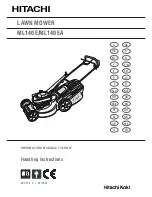
23
Failure to maintain proper torque of the wheel
nuts could result in personal injury.
Torque the front wheel nuts and rear wheel bolts to
75–80 ft.-lb. after 1–4 hours of operation and again
after 10 hours of operation. Torque every
250 hours thereafter.
Warning
Operation
Note:
Determine the left and right sides of the machine
from the normal operating position.
Controls
Adjusting the Seat
Seat adjusting lever allows 4 inches (102 mm) fore and aft
adjustment. To adjust seat fore and aft, pull lever on left
side of seat assembly outward (Fig. 21). After moving seat
to desired location, release lever to lock seat into position.
Seat adjusting knob adjusts seat for operators weight. To
adjust for operators weight, turn spring tension knob;
clockwise to increase tension, counterclockwise to decrease
spring tension (Fig. 21).
2
1
Figure 21
1. Seat adjusting lever
2. Seat adjusting knob
Traction Pedal
Controls forward and reverse operation. Depress top of
pedal to move forward and bottom to move backward
(Fig. 22). Ground speed depends on how far pedal is
depressed. For no load, maximum ground speed, fully
depress pedal while throttle is in the
fast
position. To stop,
reduce foot pressure on traction pedal and allow it to return
to center position.
1
Figure 22
1. Traction pedal
Brake Pedals
Two foot pedals operate individual wheel brakes for turning
assistance, parking and to aid in obtaining better sidehill
traction. Locking pin connects the pedals for parking brake
operation and transport (Fig. 23).
Parking Brake Latch
A knob on the left side of console actuates parking brake
lock. To engage parking brake, connect pedals with locking
pin, push down on both pedals and pull parking brake latch
out. To release parking brake, depress both pedals until
parking brake latch retracts (Fig. 23).
1
2
3
4
5
7
6
Figure 23
1. Forward speed limiter
2. Reel control light
3. Speedometer
4. Brake pedals
5. Parking brake latch
6. Locking pin
7. Key switch
Traction Speed Limiter
Preset this lever to limit the amount the traction pedal can
be depressed in the forward direction to maintain a constant
mowing speed (Fig. 23).
Reel Control Light
When lit, indicates a control system problem. The light will
illuminate when the glow plugs are preheating (Fig. 23).
Summary of Contents for 03550 Reelmaster 5500-D
Page 33: ...33 Figure 39 Figure 40 Figure 41 Figure 42 Figure 43 ...
Page 34: ...34 Service Interval Chart Figure 44 ...
Page 44: ...44 Hydraulic Schematic ...
Page 48: ...48 Wiring Diagram ...
















































